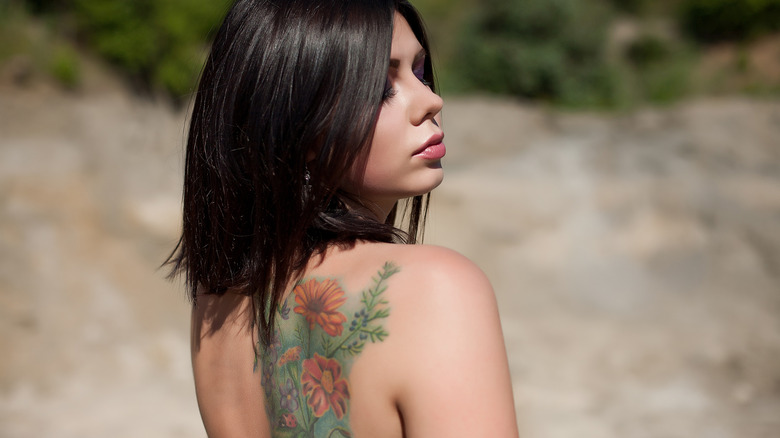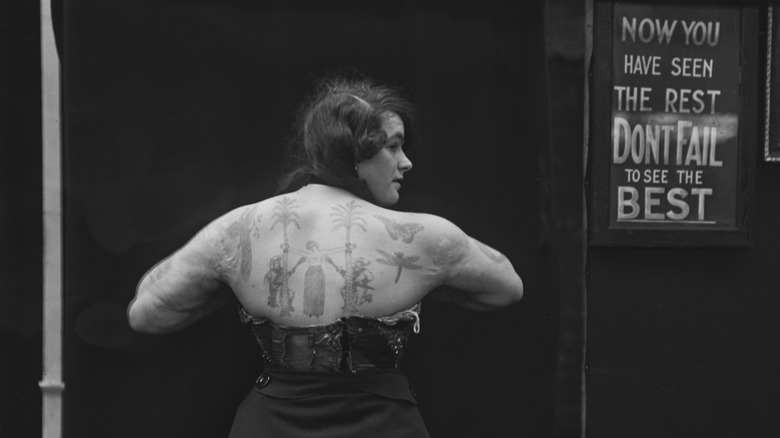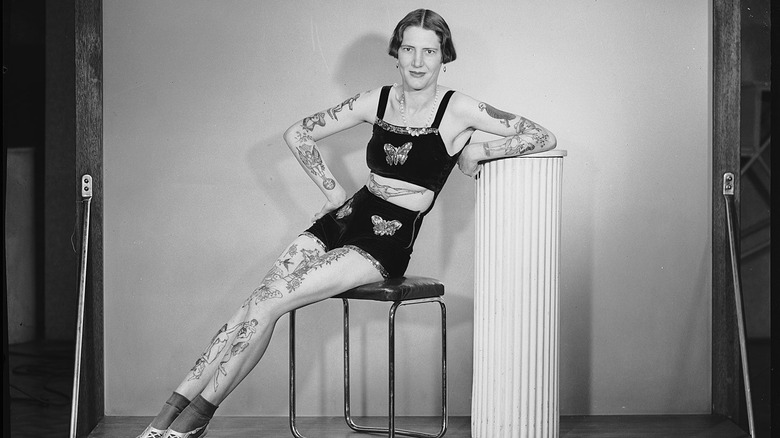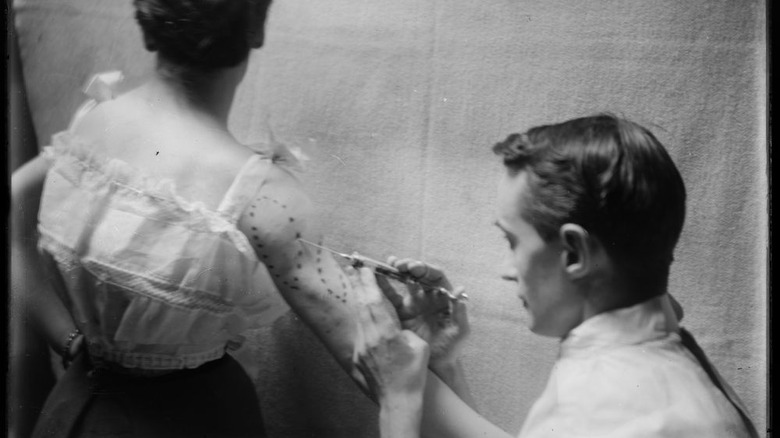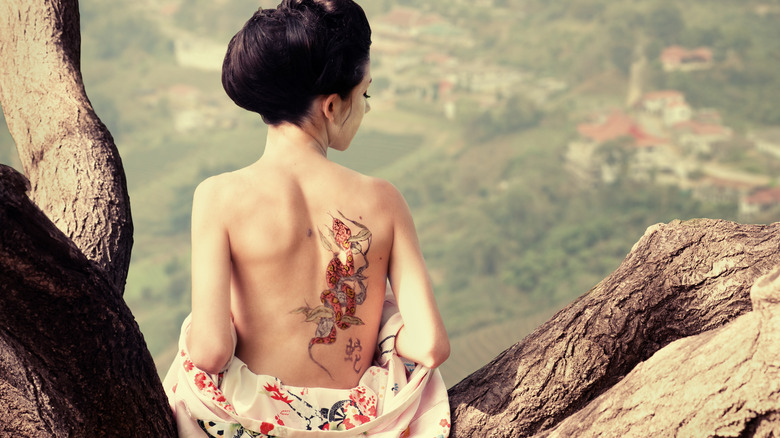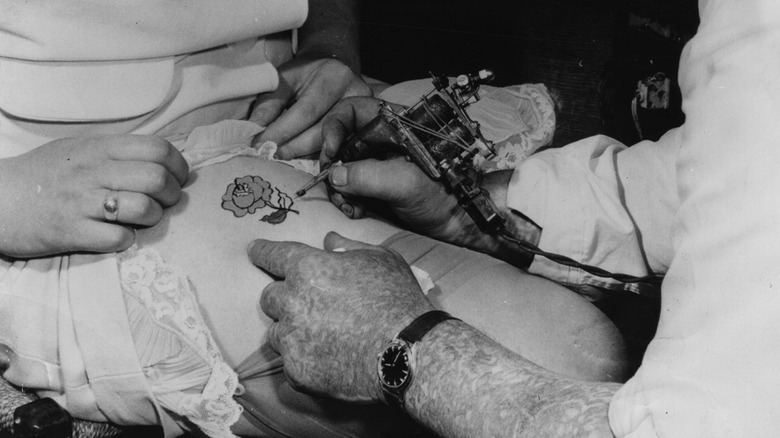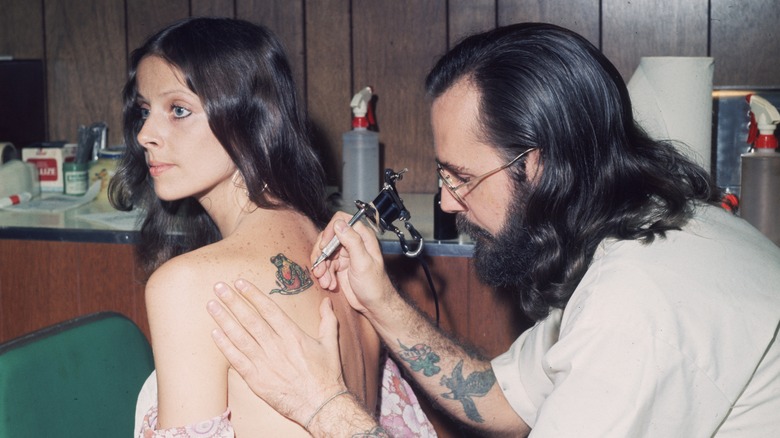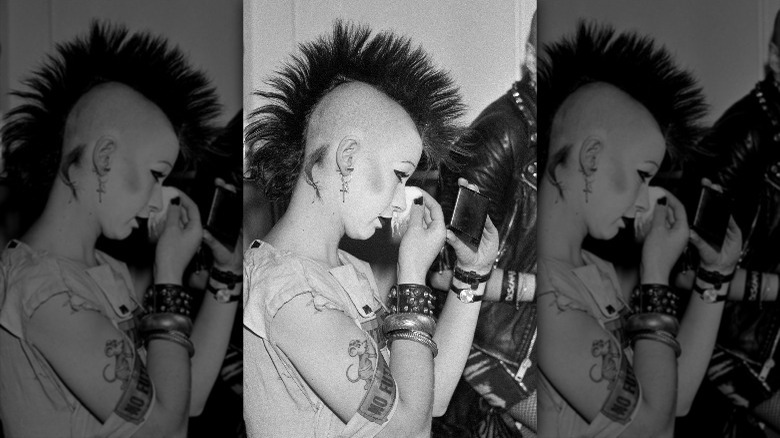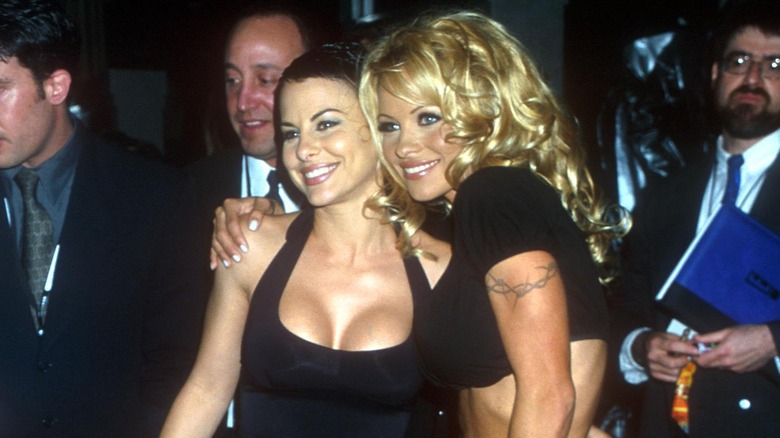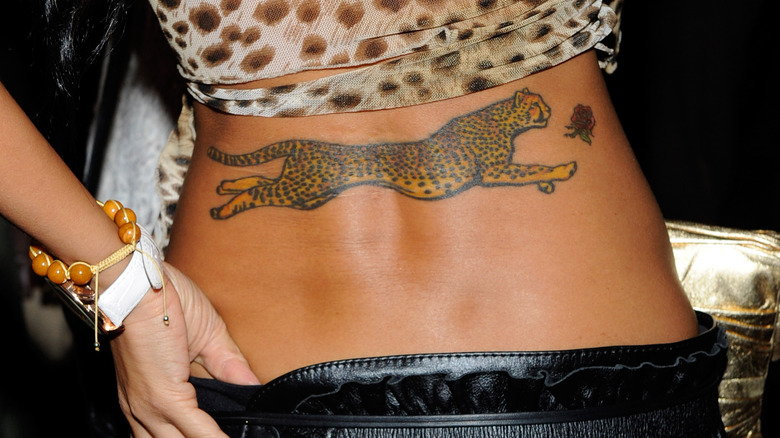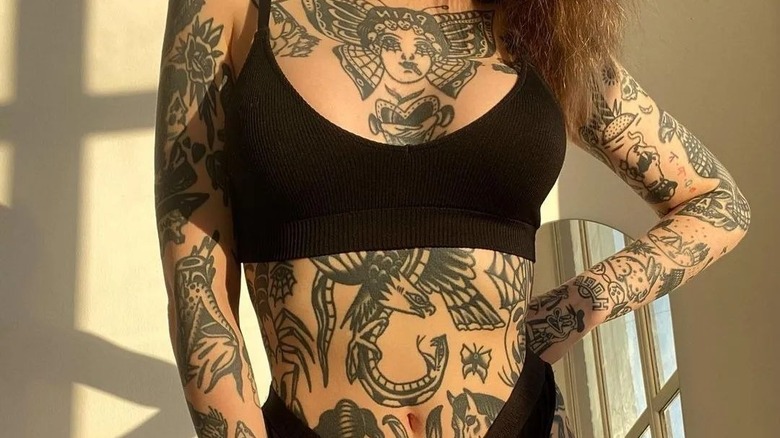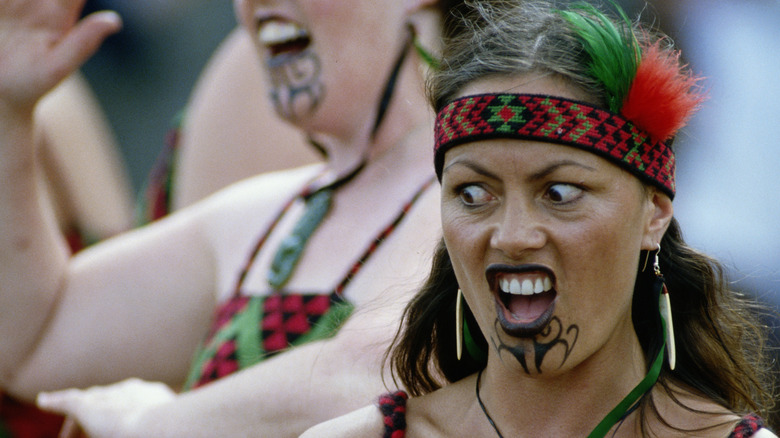100 Years Of Women's Tattoos
Despite cultural taboos, women have been getting tattoos for centuries. In ancient Egypt, women got tattoos as a form of beauty and as a status symbol. Permanent ink was seen for the first time in the West by English explorer James Cook, who observed the practice during his travels to Tahiti.
In the 19th and early 20th centuries, some women in Europe and the U.S. got tattoos to assert their independence and challenge gender norms. It's even rumored that Winston Churchill's mother was a fan of this trend and secretly had an ouroboros tattoo: a snake consuming its own tail. Nora Hildebrandt was one of the first tattooed women to appear in a freak show. She got her tattoos as a way to escape an abusive male guardian and assert her own agency. However, for a large part of history, tattoos were still largely associated with men, and women who got tattoos were often stigmatized as "loose" or "immoral." It wasn't until the feminist movement of the 1960s and '70s that tattoos began to be more widely accepted for women.
Today, tattoos are more popular than ever among women of all ages and backgrounds. From small, discreet designs to large, elaborate pieces, women use tattoos to express their personalities, as memorial tattoos for important events and people, and to assert autonomy and individuality. While there are still cultural and social barriers to women getting tattoos, the history of women and tattoos is one of resilience, creativity, and empowerment.
1920-1929: freak shows and vaudeville
Tattooed women in freak shows were also part of a larger cultural fascination with the "exotic" and the "other." This fascination often reinforced racist and sexist stereotypes, and many of these women were exploited for their appearance and their difference. Many tattooed women in freak shows came from working-class backgrounds and turned to putting themselves on display as a way to make a living. By the 1920s, there were over 300 tattooed "freaks" working in circuses across America. They were able to earn $200 a week, which was a huge salary during that time period (via Daily Mail).
For the tattooed women working on the traveling circus and vaudeville circuits, specific tattoo imagery was secondary to the shock value of a woman being completely covered in tattoos. Men in the Navy and military were the primary "mainstream" audience for tattoos at the time, so the tattoo imagery on women was similar to the images that were popular with servicemen during this time period. This includes patriotic motifs like stars and stripes, eagles, and portraits of women. It can be assumed that the women covering themselves entirely in ink were being tattooed by the same people who were tattooing for the predominately male audience.
Today, the practice of exhibiting tattooed women in freak shows is widely seen as exploitative and unethical, and the tattoo community has worked to distance itself from this history.
1930-1939: the lost years
Although tattoos were still uncommon and highly stigmatized for women during this time, there were still women rebellious enough to go against the grain. One notable tattooed woman from the 1930s was Maud Wagner, who was a circus performer and tattoo artist. Wagner was one of the first known female tattoo artists in the United States and was heavily tattooed herself, with intricate designs covering much of her body.
Perhaps it was due to her autonomy as a tattoo artist, but what makes Wagner's tattoos special compared to the other tattooed women of the time was that her tattoos were not the typical patriotic fare her contemporaries plastered across their bodies. The images tattooed on Wagner were more feminine and mirrored the modern Art Deco stylings of the time. Splashed largely and boldly across her chest is a woman riding a lion, framed by palm trees. Hummingbirds and butterflies are set to look as if they are flying amongst Wagner's full-body landscape. Wagner's tattoos were a form of artistic expression in addition to creating the shock value needed for the circus tents. She is still admired by many in the tattoo community for her skills and boldness.
Unfortunately, the names and stories of other individual women getting tattoos in the 1930s are not well-documented, and it can be difficult to find information about them. Since tattoos were still seen as taboo, the women who would have gotten them would have done so in secret.
1940-1949: the most beautifully tattooed woman in the world
One notable tattooed woman from the 1940s was Betty Broadbent, who was a sideshow performer and tattoo collector. She was often billed as "the most beautifully tattooed woman in the world" and was a popular draw for audiences. She even entered the first televised beauty pageant during the 1939 New York World's Fair. In total, Broadbent had 365 tattoos, although the imagery she chose was quite arbitrary. Many of these tattoos were portraits of famous, yet unconnected, celebrities of the day, such as Pancho Villa, Charles Lindberg, and Queen Victoria (via Cloak and Dagger). Before tattooing became more mainstream in the '70s, colored inks were limited and less vibrant than they are today. Most tattoos were done with black ink — though it was possible to create depth by shading.
It's important to note that Betty Broadbent wasn't "just" a tattooed lady. During World War II, Broadbent worked as a nurse and a secretary for the U.S. military, and she continued to collect tattoos throughout her life. In the 1970s, she was a guest on various talk shows and television programs where she spoke about her life and her tattoos. Overall, Betty Broadbent was a pioneering figure in the world of tattooing and sideshow entertainment.
1950-1959: the Japanese scene
Traditionally, there has consistently been a link between tattoos and organized crime all over the world. After World War II and during the 1950s in Japan, yakuza criminal organizations were at the height of their power, and tattooing was closely associated with the group.
The style of these tattoos was Japanese, and traditional tattooing methods were used to give them. Although it is forbidden for women to join yakuza organizations, the wives or girlfriends of men within these organizations were definitely known to be highly affiliated with these groups. These women allowed themselves to be tattooed to display their loyalty and commitment to the yakuza organizations their partners belonged to. What makes the tattoos that these women got remarkable is that they were very large and covered the entire backs of the women — something especially shocking and different in conservative East Asian cultures.
Another group of women who got tattoos during the 1940s in Japan was the members of the "mizu-shobai" or "water trade" industry, which included geishas, dancers, and other performers who worked in the entertainment industry. Some of these women got tattoos as a form of artistic expression or as a way to enhance their beauty and allure. However, it's worth noting that prostitution was officially outlawed in Japan in 1958, and many sex workers were forced to abandon their tattoos and their profession as a result of the legal crackdown.
1960-1969: counterculture rebellion
In the 1960s, it was still relatively rare for women to have tattoos, although we start to see more and more women getting them. Unlike in the decades before, women were getting tattoos as a means of self-expression: not to shock, show group affiliation, or even to earn a means of providing for themselves. During the '60s, women began to push the envelope more and more. Many women rejected the societal standards placed on them, and they showed this in their fashion. Women began to change clothing norms from feminine skirts and dresses to normalizing pants and other masculine-style clothing and styles that embodied the freedom women yearned for.
Janis Joplin was an American musician and counter-culture heavyweight who rose to fame in the late 1960s for her strong stage presence and unique singing style. Joplin had a discreet tattoo of a decorative bracelet-like design on her wrist. The design was a simple string of beads or pearls, and it was believed to have been done in San Francisco in the late 1960s. The tattoo was not very visible and was often hidden by her clothing or jewelry. Another famous female musician was also known to have a tattoo at the time was Loretta Lynn, a country musician with a good girl image who often associated herself with traditional family values. Fans might be surprised to learn that Lynn had a small heart tattoo on her left arm, which she got as a teenager in the '50s.
1970-1979: women embrace the art
As an act of liberation after getting her divorce from Sonny Bono in 1973, Cher signaled her independence by getting a large tattoo across her derriere (via Medium). It's an intricate design featuring a floral pattern with leaves and vines, something completely unusual at the time. Over the years, there have been many rumors and misconceptions about this tattoo, however, Cher has always dismissed them as unfounded and maintained that the tattoo is simply a personal expression of her own individuality and creativity — as it should be.
During the '70s, Jacci Gresham rose to prominence as a Black, female tattoo artist who began tattooing in New Orleans. Gresham faced significant obstacles as a Black woman in a male-dominated industry, and she was often subject to discrimination and harassment from clients and colleagues. However, she persevered and continued to hone her craft, eventually becoming one of the most respected and sought-after tattoo artists in the country. Gresham's work is known for its intricate detail and vivid colors, and she created many beautiful and unique designs over her career. She's also been an advocate for greater diversity and inclusion in the tattoo industry and has spoken out about the need for more opportunities and support for women and people of color in the field. She's received awards and accolades for her contributions to the tattoo industry and her advocacy work and is widely regarded as a trailblazer in the field of tattoo art.
1980-1989: up the punks
Women getting tattoos in the 1980s were part of a growing trend of body art that emerged during that decade. This was a time when many women were challenging societal expectations and seeking to assert their independence. This was the era of the punk subculture, which was known for its anti-establishment attitudes and rejection of mainstream culture. Tattoos became a popular way for punks to express their individuality and rebellion against societal norms.
The DIY ethos of punk culture also extended to tattoos, with many punks opting to give each other homemade stick and poke tattoos using rudimentary tools, such as safety pins or needles and ink. This contributed to the raw, unpolished aesthetic that was characteristic of punk tattoos in the 1980s. Punk tattoos often featured bold, graphic designs and provocative imagery, such as skulls, snakes, flames, and other symbols of danger and rebellion. Many punk tattoos also incorporated political or social commentary, such as anarchist symbols, anti-war slogans, or feminist messages. Tattoos were no longer hidden and now were placed in visible areas of the body, such as the arms, hands, or neck to serve as a statement of the wearer's punk identity and commitment to non-conformity.
Some of the most iconic female musicians of the '80s, Joan Jett, Siouxsie Sioux, and Debbie Harry of Blondie all had tattoos that were visible during their performances. Tattoos were no longer being hidden, and for the first time, they were being flaunted.
1990-1999: tattoos make it to the mainstream
The '90s saw an increasing acceptance of tattoos in mainstream culture. As tattoos became more common and less stigmatized, women of all ages and backgrounds began to get tattooed. Some of these women identified as being a part of a subculture, although many did not. Getting tattoos in the 1990s as a woman signaled a larger cultural shift towards body art as a means of self-expression and empowerment.
One of the most significant changes in the 1990s was the increasing popularity of smaller, more discreet tattoos. Unlike the bold, graphic designs of the punk era, many women in the '90s were opting for delicate, intricate tattoos that could be easily hidden or shown off depending on their preference. Popular designs for women in the '90s included butterflies, stars, flowers, and tribal symbols, as well as personal designs that had special meaning to the wearer, such as the names of loved ones or important dates.
Tattoos weren't just for musicians anymore and were being seen frequently in Hollywood, as well. Angelina Jolie began getting tattooed in the 1990s and has since become one of the most well-known tattooed celebrities. Her extensive collection includes a range of designs from small, discreet tattoos to larger, more elaborate pieces. Pamela Anderson has several tattoos, including a barbed wire armband and a tribal design on her lower back. Her tattoos became part of her iconic image as a sex symbol and symbol of female empowerment.
2000-2010: tramp stamp decade
The lower back tattoo, also known as the "tramp stamp," involved women getting mid-sized to large tattoos on the lower part of their back — typically just above the buttocks and below the waistline. These tattoos were often flashy and provocative. They were meant to be proudly on display as the trend of the era was super-low-cut jeans popularized by Britney Spears and Christina Aguilera through MTV and celebrity tabloid magazines.
The popularity of the lower back tattoo trend can be attributed to a few different factors. For one, tattoos were becoming more accepted in mainstream culture, and women were seeking new and creative ways to express themselves through body art. Additionally, the lower back was seen as a sexy and sensual area of the body, and many women saw tattoos as a way of enhancing their femininity and attractiveness. The trend also faced criticism and backlash for its association with negative stereotypes, such as the term "tramp stamp," which implied that women with lower back tattoos were promiscuous or sexually provocative. This led to some women feeling shamed or judged for their tattoos, which in turn contributed to the decline of the trend in later years.
Today, many women continue to get tattoos on their lower backs, albeit with smaller and more discreet designs that reflect changing attitudes toward body art and femininity.
2011-2019: stick and poke revival
The 2010s saw a surge in younger women getting tattooed, with many millennials and members of Generation Z opting for small, minimalistic tattoos or bold, throwback designs. Tattoos were less in-style for the mainstream celebrity crowd compared to the '90s and early 2000s, but they became very in vogue with the hipster and alternative crowds. This era of freedom made it possible for a diverse range of tattoo trends and styles to emerge. Geometric tattoos featuring bold, symmetrical designs and intricate patterns were also popular. These tattoos often incorporated shapes such as triangles, circles, or squares and may have featured repetitive patterns or mandalas. Blackwork tattoos, which feature bold, solid black ink designs with minimal shading, were another popular choice and echoed the look of the retro tattoos of the past.
Some women chose to cover much of their bodies in tattoos, as this was no longer seen as something taboo or overly rebellious. However, not everyone wanted to be a modern "tattooed lady," and it was also popular for women to get small, minimalistic tattoos placed in discreet locations, such as the wrist, ankle, or behind the ear. Script tattoos featuring cursive or calligraphy-style text designs were also popular. It also became more acceptable to get exposed body parts like the neck or the hands tattooed, something unthinkable in earlier decades.
2020-Present: beyond the West
Despite the growing mainstream acceptance of tattoos, there are still many social and cultural barriers to overcome. Many employers and members of the general public still view tattoos as unprofessional or unattractive, and women with visible tattoos are often subject to discrimination and judgment.
Recently there has been more of an awareness when it comes to tattoo traditions, beyond the West. In April 2023, Whang-Od, a 106-year-old traditional Filipina tattoo artist, was featured on the cover of Vogue magazine in her home country (via Vogue). Od is renowned for her traditional hand-tapped tattoos using thorns and bamboo sticks: A custom of the region where she is from. Od also has a large part of her body covered in this style of tattoo, and they are considered a form of cultural preservation and identity for her people.
We now have more of an awareness in regards to cultural appropriation and how it might be offensive or ignorant to get tattoos using ethnic symbols or text which we are largely unfamiliar with outside of a purely aesthetic realm. In the '90s and early 2000s, Chinese character tattoos were very popular in America due to their aesthetic appeal and perceived cultural significance, although today a tattoo like that on a Westerner would be seen as very gauche. Tattoo trends will no doubt continue to ebb and flow for decades to come as society changes and grows.
